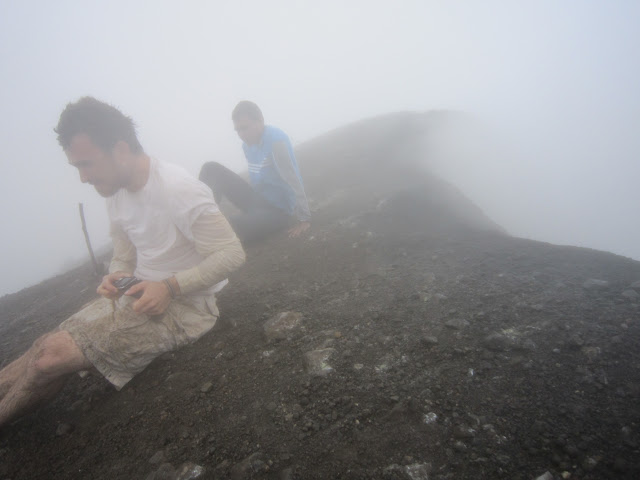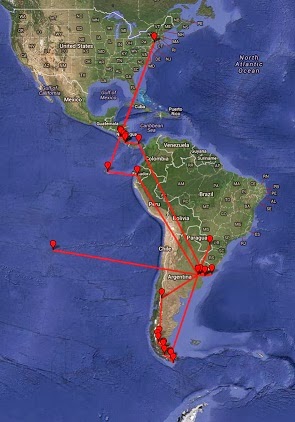Because the best jokes are the ones you need to explain, the Spanish term for "rainforest" is "Bosque de lluvia." So that's where the title of this post comes from. The reason for it is that I'm currently writing from the middle of the rainforest in the Arenal region of Costa Rica.
More specifically, I'm writing this post from Rancho Relaxo, a bit west of El Castillo. Okay, it's actually Rancho Margot, but I'm planning to lobby them for a change. As I mentioned yesterday, I'm out here to check out (from a distance) Volcán Arenal, one of the ten most active volcanoes in the world. In preparation for coming here, I scoped out my sometimes trusty Lonely Planet guide, and saw their glowing recommendation for Rancho Margot. Basically, Rancho Margot was founded by Chileno Juan Sostheim and his family in an effort to promote sustainable agriculture and community development in the Arenal region. It is a large (and stunningly beautiful) organic farm on the southwestern side of the Volcano, and houses a number of bungalows and bunkhouses, in the latter of which I'll be staying for the next two nights. All electricity is generated on site (I think it's hydroelectric, from the nearby river) and the meals feature ingredients--both animal and vegetable--raised on the farm and in the surrounding area. Tonight I had some incredibly fresh vegetables, as well as an unbelievable roasted pig (one of the volunteers here told me they slaughtered it this morning). I suppose I should add that, on top of all that, I'm writing this from a hammock, and I'm surrounded by the natural beauty of the rainforest. I should also point out that when Juan asked what I do and I told him that I would be heading to Berkeley in the fall, he mentioned that he's been in contact at various points with Berkeley prof (and noted foodie) Michael Pollen.
Anyway, tomorrow I'll get the full tour of the farm, so I expect I'll have more to report then. In the meantime though, I thought I'd talk a little more about Quepos and Manuel Antonio. I wanted to keep things fairly light in my first post yesterday, but there's certainly plenty to talk about over on the Pacific coast. The major issue in the area (which, of course, not everyone realizes) is sustainable eco-tourism. Costa Rica has taken great advantage of the concept of eco-friendly travel, but--in many cases--has unfortunately done a much better job of exploiting the label than it has of applying the philosophy. The national park system is excellent, and has protected a lot of important ecosystems. However, there are a number of places in the country where there has been little thought given to longer term sustainability, and Manuel Antonio is definitely one. It has also been generally detrimental to the area's inhabitants. The serious boost in tourism has brought a lot of money to the area, but resulted in prices that are, no joke, sometimes on par with what you see in New York. It's hard to get lunch for under $10, and a beer is never cheaper than $2. I know that's not horrible, but it's obviously a drastic change from the rest of Central America. As a New Yorker, I find New York prices less shocking than most, but it means that a lot of locals are getting priced out of the area. Even Quepos, which was historically just a small fishing town, is now too expensive for many of its inhabitands. My Spanish teacher, Sandra, is originally Quepeña, but has since moved to the slightly more remote town of Parrita. As far as I can tell, the locals view Parrita the way the British view Slough.
Another issue is that the rapid influx of luxury hotels and condos has outpaced legislation and management of the drawbacks that accompany such things. So there is no water treatment facility, meaning that most of the waste from the hotels is piped out to the ocean. As a result, though the beaches in Manuel Antonio are some of the most beautiful I've ever seen, the beach in Quepos is contaminated, and not a place one should even consider go into the water. Not all of the hotels are problematic--one called Si Como No is particularly noteworthy for its green approach. But generally speaking, the focus appears to be on cashing in while the getting is good, rather than building something that might last. The local government does what it can, keeping the regional transit hub over in Quepos, away from the parkland. The lack of nightlife on the Manuel Antonio side may well also be a result of noise regulations or something else I don't really know about. Camping overnight in the park is not permitted, and entry is limited to a certain number of visitors. So, suffice to say there is a lot that is done to protect the nature here.
Unfortunately, tourists, often unwittingly, remain a major problem. A particularly prevalent issue is interaction with the monkeys. The Central American Squirrel Monkey, which I mentioned yesterday, has very few natural habitats left, and this is one. A frustratingly common sight is a tourist giving a banana to a squirrel monkey. This is a very bad thing for a few reasons. First and foremost, the human hand carries bacteria that can be very harmful to the monkeys' digestive system, and sometimes even fatal. It also increases monkey reliance on human handouts in place of actual foraging, and moreover makes the monkeys much more aggressive than they otherwise would be (I saw one jump onto a woman who was holding a banana and take said banana out of her hand).
A large part of the problem, of course, is that people have no idea that it's bad to feed the monkeys, and they're completely adorable, so who wouldn't want a picture of their kid holding out a banana to a tiny five-fingered hand? But there needs to be a much greater effort made toward educating people about this issue when they get here. It doesn't help that the locals seem to think that telling people not to feed monkeys might cost them business. Almost none of the tourists I've encountered knew how seriously problematic an issue this is, and I only know about it because I happened to read it in the LP guide, and in Quepolandia, the local magazine for tourists (all in English). Quite honestly, it would not be hard for hotels to place a small sign in rooms just letting people know the risks, or placing signs at places that monkeys tend to congregate (like the wonderful Hospedaje Costa Linda). So instead the mechanism is just that those of us who do know see someone feeding a monkey, and can only tell them after they've already done it, thus making them feel like a huge jerk. The rapid pace of development doesn't have a quick or obvious solution, but it seems to me that a little bit of education would go a long way toward curbing the monkey feeding issue.
There's also a related issue with dolphin and whale watches. Unlike in the states, they are almost never run by qualified naturalists, and numerous tour operators have encouraged their guests to get in the water with the animals. Though they don't much mind boats, these particular dolphins and whales apparently get very skittish about people in the water, and this has, in some cases, disrupted their mating cycles. As a result, a lot of the animals are moving to calmer climes, meaning the fledgling whale watch industry here is already in decline.
Based on what I've seen (and read) thus far, this situation seems to be pretty pervasive throughout the country. Costa Rica has financially catapulted ahead of the rest of Central America in large part due to a combination of their lack of military spending and their massive tourism boom. The two, as it happens, are related, because the absence of a military means much more funding for police forces, a big part of why it's such a safe country, which feeds the tourism. But it appears to me at the moment as though current efforts to keep the ecotourism sustainable have the right idea, but in many cases are insufficient. This, as it happens, is a big part of why I wanted to come out here to Rancho Margot. Arenal is one of the most aggressively touristy areas in the country. The main hub of La Fortuna literally swarms with tour operators, both legitimate and fraudulent. Plush hotels with names in English dot the landscape, without involving themselves at all in the lives of the people who actually live here. So to come to a place that is not only actively trying to change the way people interact with their surroundings, but is reputedly having a great deal of success doing so, is really quite encouraging. I feel a little bad that my expectations are almost unfairly high right now, but the little I've seen so far has me thinking I've come to the right place to find what I'm looking for.
And with that, I'm off to catch up on some z's after three late nights out with my Man Ant peeps.
Saludos,
Seth
Fotografía:





















